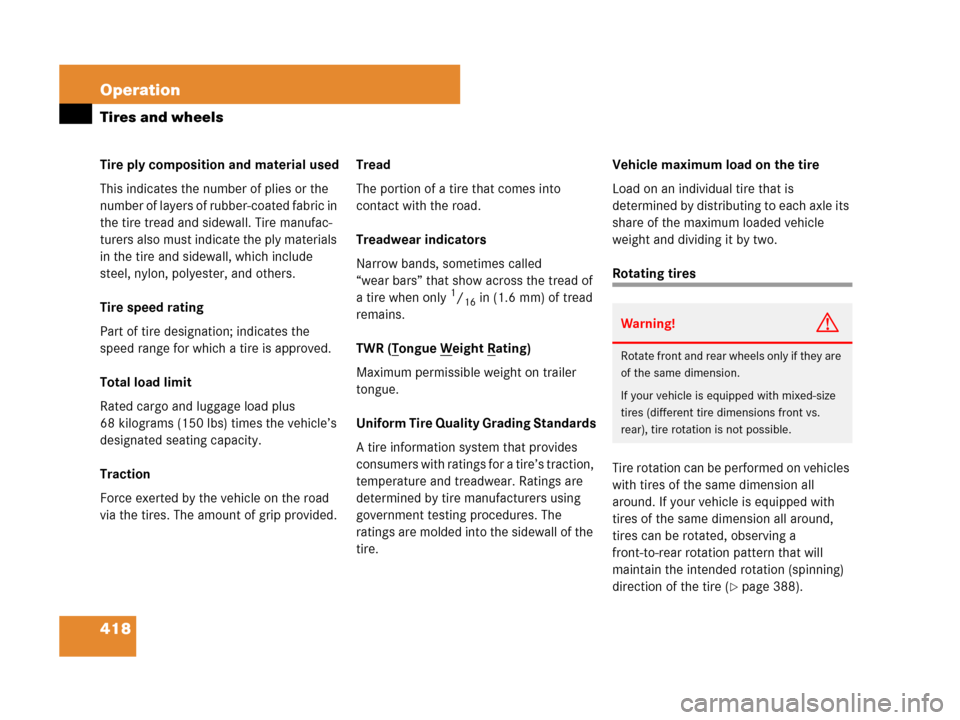Page 392 of 595

391 Operation
Tires and wheels
Step 4
�The resulting figure equals the avail-
able amount of cargo and luggage load
capacity. For example, if the “XXX”
amount equals 1400 lbs and there will
be five 150 lbs passengers in your
vehicle, the amount of available cargo
and luggage load capacity is 650 lbs
(1400-750 (5 x150) = 650 lbs).
Step 5
�Determine the combined weight of
luggage and cargo being loaded on the
vehicle. That weight may not safely
exceed the available cargo and luggage
load capacity calculated in step 4.Step 6 (if applicable)
�If your vehicle will be towing a trailer,
load from your trailer will be trans-
ferred to your vehicle. Consult this
manual to determine how this reduces
the available cargo and luggage load
capacity of your vehicle (
�page 393).
The following table shows examples on
how to calculate total and cargo load
capacities with varying seating configura-
tions and number and size of occupants.
The following examples use a load limit
of 1500 lbs. This is for illustration
purposes only. Make sure you are using
the actual load limit for your vehicle stated
on the vehicle’s Tire and Loading
Information placard (
�page 389).
Page 393 of 595
392 Operation
Tires and wheels
The higher the weight of all occupants, the
less cargo and luggage load capacity is
available.
For more information, see “Trailer tongue
load” (
�page 393).
ExampleCombined
weight limit
of occu-
pants and
cargo from
placardNumber of
occupants
(driver and
passengers)Seating
configura-
tionOccupants weight Combined
weight of all
occupantsAvailable cargo/luggage and trailer
tongue weight (total load limit from
placard minus combined weight of
all occupants)
11500 lbs5front: 2
rear: 3Occupant 1: 150 lbs
Occupant 2: 180 lbs
Occupant 3: 160 lbs
Occupant 4: 140 lbs
Occupant 5: 120 lbs750 lbs1500 lbs - 750 lbs = 750 lbs
21500 lbs3front: 1
rear: 2Occupant 1: 200 lbs
Occupant 2: 190 lbs
Occupant 3: 150 lbs540 lbs1500 lbs - 540 lbs = 960 lbs
31500 lbs1front:1Occupant 1: 150 lbs150 lbs1500 lbs - 150 lbs = 1350 lbs
Page 394 of 595

393 Operation
Tires and wheels
Certification label
Even after careful determination of the
combined weight of all occupants, cargo
and the trailer tongue load (if applicable)
(
�page 393) as to not exceed the permis-
sible load limit, you must make sure that
your vehicle never exceeds the Gross
Vehicle Weight Rating (GVWR) and the
Gross Axle Weight Rating (GAWR) for ei-
ther the front or rear axle. You can obtain
the GVWR and GAWR from the certification
label. The certification label can be found
on the driver’s door B-pillar, see “Technical
data” (
�page 547).Gross Vehicle Weight Rating (GVWR): The
total weight of the vehicle, all occupants,
all cargo, and the trailer tongue load
(
�page 393) must never exceed the
GVWR.
Gross Axle Weight Rating (GAWR): The to-
tal allowable weight that can be carried by
a single axle (front or rear).
To assure that your vehicle does not ex-
ceed the maximum permissible weight
limits (GVWR and GAWR for front and rear
axle), have the loaded vehicle (including
driver, passengers and all cargo and, if
applicable, trailer fully loaded) weighed on
a suitable commercial scale.Trailer tongue load
The tongue load of any trailer is an impor-
tant weight to measure because it affects
the load you can carry in your vehicle. If a
trailer is towed, the tongue load must be
added to the weight of all occupants riding
and any cargo you are carrying in the
vehicle. The tongue load typically is
between 8% and 15% of the trailer weight
and everything loaded in it.
For more information on trailer tongue
load, see “Loading a trailer” (
�page 367).
Page 417 of 595

416 Operation
Tires and wheels
Bar
Another metric unit for air pressure. There
are 14.5038 pounds per square inch (psi)
to 1 bar; there are 100 kilopascals (kPa)
to 1 bar.
Bead
The tire bead contains steel wires wrapped
by steel cords that hold the tire onto the
rim.
Cold tire inflation pressure
Tire inflation pressure when your vehicle
has been sitting for at least 3 hours or
driven no more than 1 mile (1.6 km).
Curb weight
The weight of a motor vehicle with stan-
dard equipment including the maximum
capacity of fuel, oil, and coolant, and, if so
equipped, air conditioning and additional
optional equipment, but without passen-
gers and cargo.DOT (Department of Transportation)
A tire branding symbol which denotes the
tire meets requirements of the
U.S. Department of Transportation.
GAWR (G
ross Axle Weight Rating)
The GAWR is the maximum permissible
axle weight. The gross vehicle weight on
each axle must never exceed the GAWR for
the front and rear axle indicated on the
certification label located on the driver’s
door B-pillar.
GTW (G
ross Trailer Weight)
The GTW is the weight of the trailer plus
the weight of all cargo, equipment, luggage
etc. loaded on the trailer.GVW (G
ross Vehicle Weight)
The GVW comprises the weight of the
vehicle including fuel, tools, spare wheel,
installed accessories, passengers and
cargo and, if applicable, trailer tongue
load. The GVW must never exceed the
GVWR indicated on the certification label
located on the driver’s door B-pillar.
GVWR (G
ross Vehicle Weight Rating)
This is the maximum permissible vehicle
weight of the fully loaded vehicle (weight of
the vehicle including all options, passen-
gers, fuel, and cargo and, if applicable,
trailer tongue load). It is indicated on
certification label located on the driver’s
door B-pillar.
Kilopascal (kPa)
The metric unit for air pressure. There are
6.9 kPa to 1 psi; another metric unit for air
pressure is bars. There are 100 kilopascals
(kPa) to 1 bar.
Page 419 of 595

418 Operation
Tires and wheels
Tire ply composition and material used
This indicates the number of plies or the
number of layers of rubber-coated fabric in
the tire tread and sidewall. Tire manufac-
turers also must indicate the ply materials
in the tire and sidewall, which include
steel, nylon, polyester, and others.
Tire speed rating
Part of tire designation; indicates the
speed range for which a tire is approved.
Total load limit
Rated cargo and luggage load plus
68 kilograms (150 lbs) times the vehicle’s
designated seating capacity.
Traction
Force exerted by the vehicle on the road
via the tires. The amount of grip provided.Tread
The portion of a tire that comes into
contact with the road.
Treadwear indicators
Narrow bands, sometimes called
“wear bars” that show across the tread of
a tire when only
1/16in (1.6 mm) of tread
remains.
TWR (T
ongue Weight Rating)
Maximum permissible weight on trailer
tongue.
Uniform Tire Quality Grading Standards
A tire information system that provides
consumers with ratings for a tire’s traction,
temperature and treadwear. Ratings are
determined by tire manufacturers using
government testing procedures. The
ratings are molded into the sidewall of the
tire.Vehicle maximum load on the tire
Load on an individual tire that is
determined by distributing to each axle its
share of the maximum loaded vehicle
weight and dividing it by two.
Rotating tires
Tire rotation can be performed on vehicles
with tires of the same dimension all
around. If your vehicle is equipped with
tires of the same dimension all around,
tires can be rotated, observing a
front-to-rear rotation pattern that will
maintain the intended rotation (spinning)
direction of the tire (
�page 388).
Warning!G
Rotate front and rear wheels only if they are
of the same dimension.
If your vehicle is equipped with mixed-size
tires (different tire dimensions front vs.
rear), tire rotation is not possible.
Page 491 of 595
490 Practical hints
What to do if …
Display symbolDisplay messagesPossible cause/consequencePossible solution
nLevel selection
not permittedYou are driving too fast for the desired
vehicle level.�Reduce vehicle speed.
�Set the desired vehicle level again
(
�page 281).
You are towing a trailer or using acces-
sories that are connected to the trailer
power socket, e.g. a bicycle rack.
Leveling cancelledYou have selected another vehicle
level*.
pReduce speed to
under 20 mphYou are driving too fast for the set vehi-
cle level.�Do not drive faster than 20 mph
(30 km/h).
Visit workshopThe air suspension functional only to a
limited extent.�Do not drive faster than 50 mph
(80 km/h) depending on the set
vehicle level.
�Have the vehicle checked at an au-
thorized Mercedes-Benz Light
Truck Center.
Door open
Veh. lowering canceledYou have opened a door or the tailgate
while the vehicle is being lowered.
Page 544 of 595
543 Practical hints
Towing the vehicle
Installing cover
�Engage cover1 at top and press at
bottom.
Stranded vehicle
Freeing a stranded vehicle, on which the
wheels are dug into sand or mud, should
be done with the greatest of care, especial-
ly if the vehicle is heavily loaded.
Avoid pulling the vehicle abruptly or diago-
nally, since it could result in damage to the
chassis alignment.
Never try to free a vehicle that is still cou-
pled to a trailer.
If possible, a vehicle equipped with trailer
hitch receiver should be pulled backward
in its own previously made tracks.
Page 570 of 595

569 Index
A
ABS 103
Indicator lamp 436
Messages in the
multifunction display 453
Off-road - ABS 104
Accelerator position, automatic
transmission 198
Accessory weight 415
Accident 67
Active head restraint 92, 135, 504
Adaptive Damping System (ADS)* 280
Air bags 76
Children 77, 93
Front passenger front air bag off
indicator lamp 31, 32, 85
Front, Driver 79
Front, Passenger 79
Occupant Classification System*
(OCS) 81
Safety guidelines 78
Side impact (front and rear*) 80
Window curtain 80Air conditioning refrigerant 562
Air conditioning system see
Climate control or
Automatic climate control (3-zone)*
Air conditioning, Cooling 226, 241
Air distribution, Front 221, 236
Air distribution, Rear 229, 245
Air pressure see Tire inflation pressure
Air recirculation mode 224, 239
Air suspension package 280
Adaptive Damping System
(ADS)* 280
Messages in the
multifunction display 490
Vehicle level control 281
Air vents 229
Air vents*, Rear 246
Air vents, Front 222, 236
Air volume 222, 237
Alarm system see Anti-theft systems
Alignment bolt (vehicle tool kit) 496, 526
Anticorrosion/antifreeze 561, 566Antiglare, Interior rear view mirror 210
Antiglare, Rear view mirrors* 211
Antilock Brake System see ABS
Anti-theft systems 112
Anti-theft alarm system 111, 112
Immobilizer 111
Aquaplaning see Hydroplaning
Armrest storage compartments
Front 318
Ashtrays* 322
Aspect ratio 415
ATF 382
Attaching a trailer 368
Audio menu 166
CD operation 167
Radio operation 166
Satellite radio* operation
(USA only) 166
Auto-dimming*, Rear view mirrors 211
Automatic central locking,
Control system 183